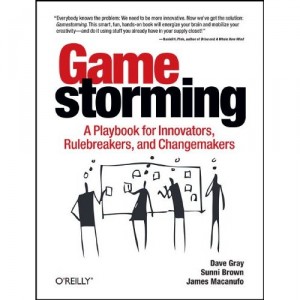 I’ve been a professional facilitator, of some sort, for the better part of the last 15 years. I’ve taken, and given, a good deal of training related to tools, techniques, and methods for idea generation and meeting facilitation. I’m regarded as one of the best. I say all this not to toot my own horn (toot toot) but as a preface to a review on possibly the best book written about the subject in many years, GameStorming, a Playbook for Inovators, Rulebreakers, and Changemakers. I know a lot of tools, but these guys put them all (nearly all) in a great book!
I’ve been a professional facilitator, of some sort, for the better part of the last 15 years. I’ve taken, and given, a good deal of training related to tools, techniques, and methods for idea generation and meeting facilitation. I’m regarded as one of the best. I say all this not to toot my own horn (toot toot) but as a preface to a review on possibly the best book written about the subject in many years, GameStorming, a Playbook for Inovators, Rulebreakers, and Changemakers. I know a lot of tools, but these guys put them all (nearly all) in a great book!
There are a number of books out there on idea generation (and meeting facilitation) methods. What’s I’ve found lacking in them is the lack of a fresh take, a lack of diversity in tools, or not having a unifying principle. In GameStorming, Dave Gray, Sunni Brown, and James Macanufo address these concerns.
It starts with an approach as to how activities and exercises (aka “games”) in workshops ought to be structured, conceptually. It also explores how games can be strung together to create cohesive meetings. It teaches you how to fish, so to speak, instead of just giving you a formulaic set of rules and procedures. Best approach to game design writing I’ve ever read on the subject, flat out, this is really good stuff.
The diversity of games described is remarkable. It covers everything from Post-it note brainstorming to Pecha Kucha and a lot in between. It’s also good in that it has games for more than just ideation, it also games for Exploring, Discussion, Closing, Convergence. It includes some of the more advanced techniques I’ve seen, including The World Cafe (dialog), and graphic facilitation techniques the Grove made famous. It also surprised me with delightfully useful games I’d not seen documented anywhere (and it’s hard to surprise me!).
It touches briefly upon one of my favorite categories of games, which is improvisation. In this area, I have a minor critical remark to make — and that’s simply that there is not enough about it in GameStorming. The discussion of improv is thoughtful, but only a few improvisational games are included in the book. So, I’d have to conclude that the book comes from a Graphic Facilitation bias — and that’s okay, nearly every exercise one might do in a session has to be rendered to paper in some form. So, it’s a small point I’m making, but maybe in edition 2 they can go one better. GamesStorming goes in the direction of more whole brained activities, and that’s progress.
Overall, this is the best book I’ve read on modern-day facilitation techniques. If you facilitate, even part time within a company, this is a highly useful, comprehensive, and important book.


